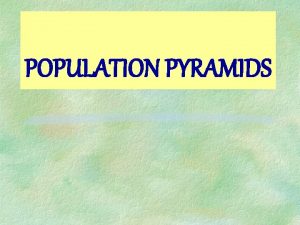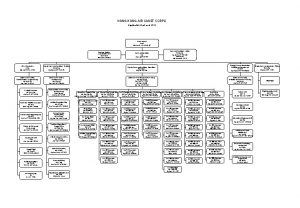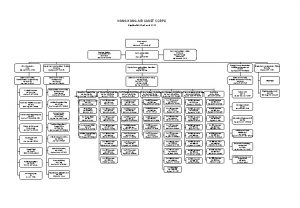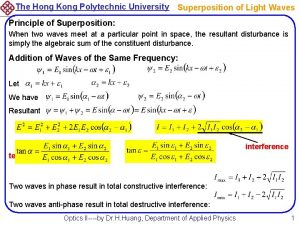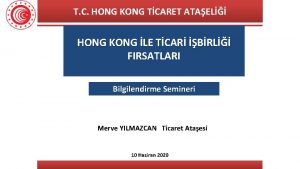The Hong Kong Polytechnic University Light Waves Nature















- Slides: 15

The Hong Kong Polytechnic University Light Waves Nature of Light: Light can be viewed as both stream of particles and electromagnetic waves. One-Dimensional Wave: Longitudinal wave: the medium is displaced in a direction of motion of the wave. Transverse wave: the medium is displaced in a direction of motion of the wave. Feature: the disturbance advances, not the material medium. Optics II----by Dr. H. Huang, Department of Applied Physics 1

The Hong Kong Polytechnic University Light Waves Wave Profile: In positive x-direction: In negative x-direction: Optics II----by Dr. H. Huang, Department of Applied Physics 2

The Hong Kong Polytechnic University Light Waves Harmonic Waves (Sine Waves) : Propagation number: k Amplitude: A Wavelength: Temporal period: Frequency: Angular frequency: Wave number: Various forms: Optics II----by Dr. H. Huang, Department of Applied Physics 3

The Hong Kong Polytechnic University Light Waves Example: Given the traveling wave function find the frequency, the wavelength, the temporal period, the amplitude, and the direction of motion. The wave function and x are in meters, t is in seconds. Example: The speed of electromagnetic waves in vacuum is 3 108 m/s. Find the frequency of yellow-green light of wavelength 555 nm. Overhead power lines radiate electromagnetic waves at a frequency of 50 Hz. Compare the wavelength with yellow -green light. Optics II----by Dr. H. Huang, Department of Applied Physics 4

The Hong Kong Polytechnic University Light Waves Phase and Phase Velocity: Initial Phase: 0 Phase: Phase velocity: Properties of Waves: Wavefront: line that links all the points of the same phase Ray: line perpendicular to all wavefronts Plane waves: wavefronts are planes Spherical waves: wavefronts are spheres Optics II----by Dr. H. Huang, Department of Applied Physics 5

The Hong Kong Polytechnic University Light Waves Polarization: If all the oscillations are confined within a plane, the wave is called a plane polarized wave. If the wave oscillations are random in all directions, it is an unpolarized wave. Unpolarized wave consists of randomly oriented plane polarized waves. Amplitude and Intensity: The wave carries an energy that is proportional to the square of its amplitude. The amount of energy passing through unit area per second is defined as the intensity of the wave. Therefore the intensity is also proportional to the speed of light in the medium. Optics II----by Dr. H. Huang, Department of Applied Physics 6

The Hong Kong Polytechnic University Light Waves Wavelength and Frequency in a medium: The frequency of light in the medium is unchanged. Wave Packets or Groups: Mathematically, a wave packet with a finite length consists of a group of frequencies. The smaller the number of frequencies in a wave packet then the greater will be the length of the wave packet. Different frequencies in a group mean different wavelengths. It can be shown that the spread of wavelength about the mean wavelength is, Optics II----by Dr. H. Huang, Department of Applied Physics 7

The Hong Kong Polytechnic University Light Waves Reflection and Transmission: For normal incidence: Optics II----by Dr. H. Huang, Department of Applied Physics 8

The Hong Kong Polytechnic University Light Waves Reflectance and Transmittance (normal incidence): Poynting vector: Optics II----by Dr. H. Huang, Department of Applied Physics 9

The Hong Kong Polytechnic University Light Waves Phase Change: For n >n, r <0 while r// change sign at the incidence angle ip, where i +ip=90. The reflected ray is perpendicular to the transmitted one. At this incidence angle, r//=0, the reflected electric vector is plane polarized in a direction perpendicular to the plane of incidence. The angle ip is called the polarization angle or Brewster’s angle (i. B). In the internal reflection case, there will be no transmission when the incidence angle is larger than a critical angle ic, For near normal incidence or the glancing incidence, there is a phase shift for external reflection and zero phase shift for internal reflection. Phase changes for the reflected components of the electric vector E at the interface between two media with refractive indices n =1. 5 and n=1. Optics II----by Dr. H. Huang, Department of Applied Physics 10

The Hong Kong Polytechnic University Light Waves Stokes Relation: Using the principle of reversibility for optical rays: Optics II----by Dr. H. Huang, Department of Applied Physics 11

The Hong Kong Polytechnic University Light Waves Example: What is the distance along the wave (in the direction of propagation) between two points having a phase difference of 60 if the wave velocity is 3 108 m/s and the frequency is 6 1014 Hz? What phase shift occurs at a given point in 10 -3 seconds and how many waves pass by in that time? Example: Write an expression for the infrared wave shown in the right figure. Optics II----by Dr. H. Huang, Department of Applied Physics 12

The Hong Kong Polytechnic University Light Waves Example: Given the function when t=0, t= /4, t= /2, t=3 /4, and t= ? what is the value of the function at x=0 Example: A parallel circular beam of light is incident normally on a perfectly absorbing plane surface. If the intensity of the beam is 20 W/cm 2 and its diameter is cm, how much energy is absorbed by the surface in 2 minutes? Example: The vacuum wavelength of a light wave is 750 nm. What is its propagation number in a medium of refractive index 1. 5? Optics II----by Dr. H. Huang, Department of Applied Physics 13

The Hong Kong Polytechnic University Light Waves Example: An empty tank is 30 m long. Light from a sodium lamp ( =589 nm) passes through the tank in time t 1 when filled with water of refractive index 1. 33. When filled with carbon disulphide of refractive index 1. 63 it takes a time t 2. Find the difference in the transit times. The speed of light in vacuum is c=3 108 m/s. Example: A beam of white light is incident normally on a plane surface separating air from glass. If the refractive indices for particular ‘red, green, and violet’ light wavelengths are 1. 45, 1. 50, and 1. 55, respectively, find the reflectances for each color. Optics II----by Dr. H. Huang, Department of Applied Physics 14

The Hong Kong Polytechnic University Light Waves Example: A film of cryolite (Na 3 Al. F 6) of refractive index 1. 31 is deposited on a glass substrate. If three-quarters of a wavelength of light with vacuum wavelength 555 nm is to occupy the film, how thick must the film layer be? Homework: 10. 1; 10. 3; 10. 5; 10. 7; 10. 9; 10. 14 Optics II----by Dr. H. Huang, Department of Applied Physics 15
 Cu library
Cu library Hong kong baptist university school of communication
Hong kong baptist university school of communication The education university of hong kong
The education university of hong kong The education university of hong kong
The education university of hong kong City university of hong kong
City university of hong kong What are some limitations of central place theory
What are some limitations of central place theory Abderazek ben abdallah
Abderazek ben abdallah Sound waves are longitudinal waves true or false
Sound waves are longitudinal waves true or false Hkmc
Hkmc The hong kong institute of chartered secretaries
The hong kong institute of chartered secretaries Pestel analysis of san miguel corporation
Pestel analysis of san miguel corporation Beehive shaped population pyramid
Beehive shaped population pyramid Extranetapps hongkongairport com/opas/public
Extranetapps hongkongairport com/opas/public Hkeaa ap
Hkeaa ap Hong kong air cadet corps
Hong kong air cadet corps Hong kong air cadet corps
Hong kong air cadet corps











